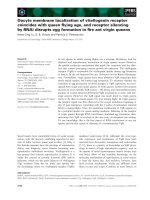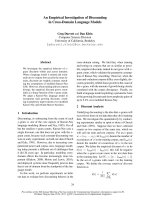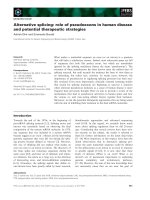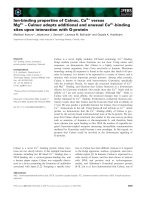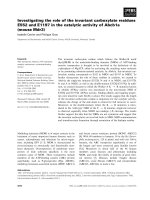Báo cáo khoa học: "Identifying Syntactic Role of Antecedent in Korean Relative Clause Using Corpus and Thesaurus Information" pdf
Bạn đang xem bản rút gọn của tài liệu. Xem và tải ngay bản đầy đủ của tài liệu tại đây (611.67 KB, 7 trang )
Identifying Syntactic Role of Antecedent in Korean Relative
Clause Using Corpus and Thesaurus Information
Hui-Feng Li, Jong-Hyeok Lee,
Geunbae Lee
Department of Computer Science and Engineering
Pohang University of Science and Technology
San 31 Hyoja-dong, Nam-gu, Pohang 790-784, Republic of Korea
, {jhlee, gblee)@postech.ac.kr
Abstract
This paper describes an approach to identify-
ing the syntactic role of an antecedent in a Ko-
rean relative clause, which is essential to struc-
tural disambiguation and semantic analysis. In
a learning phase, linguistic knowledge such as
conceptual co-occurrence patterns and syntac-
tic role distribution of antecedents is extracted
from a large-scale corpus. Then, in an appli-
cation phase, the extracted knowledge is ap-
plied in determining the correct syntactic role
of an antecedent in relative clauses. Unlike pre-
vious research based on co-occurrence patterns
at the lexical level, we represent co-occurrence
patterns with concept types in a thesaurus. In
an experiment, the proposed method showed a
high accuracy rate of 90.4% in resolving am-
biguitie s of syntactic role determination of an-
tecedents.
1 Introduction
A relative clause is the one that modifies an an-
tecedent in a sentence. To determine the syn-
tactic role of the antecedent in a verb argu-
ment structure of relative clause is important in
parsing and structural disambiguation(Li et al.,
1998). While applying case frames of a verb for
structural disambiguation, identifying the role
of antecedent will affect the correctness of struc-
tural disambiguation impressively.
In this paper, we will describe a method of
identifying the syntactic role of antecedents,
which consists of two phases. First, in the
learning phase, conceptual patterns (CPs) and
syntactic role distribution of antecedents are
extracted from a corpus of 6 million words,
the Korean Language Information Base (KLIB).
The conceptual patterns reflect the possible case
restriction of a verb with concept types, while
the syntactic role distribution shows the prefer-
ence of syntactic role of antecedents of a verb.
Second, in the application phase, the syntactic
role of an antecedent is decided using CPs and
the syntactic role distribution.
In regards to the rest of this paper, Section
2 will review the problems and related work.
Section 3 will describe a statistical approach
of conceptual pattern extraction from a large
corpus as knowledge for determining syntactic
roles. Section 4 will describe how to identify
syntactic roles using conceptual patterns and
syntactic role distribution of antecedents in the
corpus. Section 5 will then present an experi-
mental evaluation of the method. The last sec-
tion makes a conclusion with some discussion.
The Yale Romanization is used to represent Ko-
rean expressions.
2 Problems and Related Work
In English, it is possible to recognize the syntac-
tic role of antecedents by their position (trace)
in relative clauses and the valency information
of verbs. For example, the syntactic role of an
antecedent
man
can be recognized as subject of
the relative clause in a sentence "He is the
man
who lives next door" and as object in a sen-
tence "He is the
man
whom I met." The rela-
tive pronouns such as
who, whom, that, whose,
and
which
can also be used in identifying the
role of antecedents in relative clauses.
However, it is not a trivial work to identify
the syntactic role of antecedents in Korean rel-
ative clauses. Korean is such a head final lan-
guage that the antecedent comes after the rel-
ative clause. The rest of this section will de-
scribe three main characteristics of Korean rel-
ative clauses that make it difficult to determine
the syntactic role of their antecedents. The first
characteristic is that unlike English, Korean
lacks relative words corresponding to English
756
SOT."
, °°,.=, ,°.°. °o°o,o.op
Figure 1: Syntactic dependency tree for (1)
relative pronouns. Instead, an adnominal verb
ending follows its verb stem of a relative clause
modifying an antecedent. The adnominal verb
ending does not provide any information about
the syntactic role of antecedent. For example,
the relative clause
kang-eyse hulu-
(flow in a
river) in sentence (1) modifies the antecedent
mwul-
(water), while adnominal verb ending -
nun
provides no clue about the syntactic role of
the antecedent
mwul
(water). Figure 1 shows
the syntactic dependency tree (SDT) of sen-
tence (1). We need to decide the syntactic role
of the antecedent
mwul-
(water) in the argu-
ment structure of the verb
hulu-
(flow) when
applying case frames of the verb for structural
disambiguation. The dependency parser (Lee,
1995) only gives the syntactic relation
mod
be-
tween them, which should be regarded as
subject
in the relative clause.
(1)
nanun kang-eyse hulu-nun mwul-lul poatt-
ta.
(I saw water that flowed in a river.)
As the second characteristic, the syntac-
tic role of an antecedent cannot be determined
by word order. This is because Korean is a rel-
atively free word-order language like Japanese,
Russian, or Finnish, and also because some ar-
guments of a verb may be frequently omitted.
In sentence (2), for example, the verb of rela-
tive clause
nolay-lul pwulless-ten
(where [I] sang
a song [at the place]) have two arguments [I]
and [place] omitted. Thus, the antecedent
kos-
(place) might be identified as
subject
or
adver-
bial
in the relative clause.
~B
I' I
Figure 2: System architecture
(2)
nolay-lul pwulless-ten kos-ey na-nun kass-
ta.
(I went to the place where [I] sang a song
[at the place].)
The third characteristic of Korean relative
clauses is that the case particle of an antecedent,
that indicates the syntactic role in the relative
clause, is omitted during relativization. In fact,
in a relatively free-word order language, the case
particles are very important to the syntactic role
determination.
Due to lack of syntactic clues, it is very dif-
ficult to construct general rules for identify-
ing the syntactic role of antecendents. Thus,
the corpus-based method has been prefered
to the rule-based one in solving the prob-
lem of syntactic role determination in Korean
relative clauses. Yang and Kim (1993) pro-
posed a corpus-based method, where, for each
noun/verb pair, its word co-occurrence and sub-
categorization scores are extracted at lexical
level. Park and Kim (1997) described a method
of semantic role determination of antecedents
using verbal patterns and statistic information
from a corpus. These word co-occurrence pat-
terns are all at lexical-level, so we have to con-
struct a large amount of word co-occurrence
patterns and statistical information before ap-
plying to a real large-scale problem. Actually,
the system performance mainly relies on the do-
main of application, the number of word co-
occurrence patterns extracted, and the size of
corpus.
757
In the following sections, we will describe
an approach to acquiring statistical information
at conceptual level rather than at lexical level
from a corpus using conceptual hierarchy in the
Kadokawa thesaurus titled
New Synonym Dic-
tionary
(Ohno and Hamanishi, 1981), and also
describe a method of syntactic role determina-
tion using the extracted knowledge. The system
architecture is shown in Figure 2.
3 Extraction of Statistic Information
from Corpus
First, for each of 100 verbs selected by order of
frequency in the KLIB (Korean Language In-
formation Base) corpus of 6 million words, its
syntactic relational patterns (SRPs) of the form
(Noun, Syntactic relation, Verb)
are extracted
from the corpus. Then, the nominal words in
the SRPs are substituted with their correspond-
ing concept codes at level 4 of the Kadokawa
thesaurus. A nominal word may have multi-
ple meanings such as
C1,C2, , Cn.
However,
since we cannot determine which meaning of
the nominal word is used in a SRP, we uni-
1
formly add n to the frequency of each concept
code. Through this processing, the syntactic
relational pattern (SRP) changes into the con-
ceptual frequency pattern (CFP), ({< C1, fl >
,< C2, f2
>, ,<
Crn, fm >},SRj,Vk),
where
Ci
represents a concept code at level four of the
Kadokawa thesaurus,
fi
indicates the frequency
of the code
Ci,
and
SRj
shows a syntactic rela-
tion between these concept codes and verb
Vk.
These patterns are then generalized by a con-
cept type filter into more abstract conceptual
patterns (CPs), {({el, C2, ,
Cn},
SRj,
Vk)ll <
j < 5, 1 _< k < 100}. Unlike in CFPs, the con-
cept code in the more generalized CPs may be
not only at level four (denoted as L4), but also
at level three (L3) and two (L2). In addition
to the CPs, we also extract the syntactic role
distributiion of antecedents.
3.1 Retrieving Syntactic Relational
Patterns from Corpus
Unlike the conventional parsing problem whose
main goal is to completely analyze a whole sen-
tence, the extraction of syntactic relational pat-
terns (SRPs) aims to partially analyze sentences
and thus to get the syntactic relations between
nominals and verbs. For this, we designed a
partial parser, the analysis result of which is
obviously not as precise as that of a full-parser.
However, it can provide much useful informa-
tion. For the set of 100 verbs, a total of 282,216
syntactic relational patterns (SRPs) was ex-
tracted from the KLIB corpus. During the gen-
eralization step, the problematic patterns are
filtered out.
In Korean, the syntactic relation of nominal
words toward a verb is mainly determined by
case particles. During the extraction of SRPs
(Ni, SRj,Vk),
we only consider the syntactic
relation
SRjs
determined by 5 types of case
particles: nominative
(-i/ka/kkeyse),
accusative
(-ul/lul),
and three adverbial
(-ey/eynun,
se/eyse/eysenun, -to/ulo/ulonun).
3.2 Conceptual Pattern Extraction
3.2.1 Thesaurus Hierarchy
For the purpose of type generalization of nom-
inal words in SRPs, the Kadokawa thesaurus
titled
New Synonym Dictionary
(Ohno and
Hamanishi, 1981) is used, which has a four-level
hierarchy with about 1,000 semantic classes.
Each class of upper three levels is further di-
vided into 10 subclasses, and is encoded with a
unique number. For example, the class
'station-
ary'
at level three is encoded with the number
96
and classified into ten subclasses, Figure 3
shows the structure of the Kadokawa thesaurus.
To assign the concept code of Kadokawa
thesaurus to Korean words, we take advan-
tage of the existing Japanese-Korean bilingual
dictionary (JKBD) that was developed for a
Japanese-Korean MT system called COBALT-
J/K. The bilingual dictionary contains more
than 120,000 words, the meaning of which is en-
coded with the concept codes that are at level
four in the Kadokawa thesaurus. Thus, Korean
words in the SRPs are automatically assigned
their corresponding concept codes of level four
through JKBD.
3.2.2 Principle of Generalization
We encoded the nouns in SRPs extracted by the
parser with concept codes from the Kadokawa
thesaurus, and examined histograms of the fre-
quency of concept codes. We observed that the
frequency of codes for different syntactic rela-
tions of a verb showed very different distribution
shapes. This means that we could use the dis-
tribution of concept codes, together with their
frequencies as clues for conceptual pattern ex-
758
concept
I
I I i I I I I I i I
•
I : ;J ~ s 6 ~
I
•
' I
I I t I I I I I 1 I "i I I I I I I I I
o~
(~1 e~z ~ u~ oss qt~6 w'9
isl
O~9
~o
9~1
9~1 9~ ~4 I ~S6 ~ 9Sa 9~
Figure 3: Concept hierarchy of Kadokawa the-
saurus
traction. From the histograms of codes of both
subject and object relational patterns for the
verb
ttena-ta
(leave), we observed that concept
codes about human (codes from 500 to 599) ap-
pear most frequently in the role of subject, and
codes of position (from 100 to 109), codes of
place (from 700 to 709) and codes of building
(from 940 to 949) appear most often in the role
of object.
For each verb
Vk,
we first analyzed the co-
occurrence frequencies
fi
of concept codes
Ci
of noun N, and then computed an average fre-
quency
fave,t
and standard deviation
at
around
lave,t,
at level g (denoted as Lt) of the con-
cept hierarchy. We then replaced
fi
with its
associated z-score
k$,e. k$,e
is the strength of
code frequency f at Lt, and represents the
standard deviation above the average of fre-
quency
fave,t.
Referring to Smadja's definition
(Smadja, 1993), the standard deviation at at
Lt and strength
kf,t
of the code frequencies are
defined as shown in formulas 1 and 2.
nt 2
:_fow,t)
at = V nt - 1 (1)
k$,,,,t = fi,t
-
fave,t
(2)
at
where
fi,t
is the frequency of concept code
Ci
at
Lt
of Kadokawa thesaurus,
fave,t
is the average
frequency of codes at Lt, nt is the number of
concept codes at Lt.
3.2.3 Code Generalization
The standard deviation at at Lt characterizes
the shape of the distribution of code frequen-
Level
Threshold of standard deviation O'OT l
Threshold of
subj obj advl adv2 adv3 Strength ko,t
L4 2.0 8.0 0.5 0.1 0.9 k0,4=4.0
L3 6.0 16.0 1.5 2.0 2.0 k0,3=l.0
L2 30.0 50.0 15.0 4.0 10.0 ko,2=-0.60
Table 1: Thresholds of the filter
cies. If al is small, then the shape of the his-
togram will tend to be flat, which means that
each concept code can be used equally as an ar-
gument of a verb with syntactic role
SRi.
If
at is large, it means that there is one or more
codes that tend to be peaks in the histogram,
and the corresponding nouns for these concept
codes are likely to be used as arguments of a
verb. The filter in our system selects the pat-
terns that have a variation larger than threshold
a0,t, and pulls out the concept codes that have a
strength of frequency larger than threshold k0,l.
If the value of the variation is small, than we
can assume there is no peak frequency for the
nouns. The patterns that are produced by the
filter should represent the concept types of ex-
tracted words that appear most frequently as
syntactic role
SRi
with verb
Vk.
We later analyzed the distribution of fre-
quency f/ in
CFPjs
to produce an aver-
age frequency fave,t and standard deviation
at. Through experimentation, we decided
the threshold of standard deviation a0,t and
strength of frequency k0,t as shown in Table 1.
The lower the value of threshold k0,t is assigned,
the more concept codes can be extracted as
conceptual patterns from the CFPs. We main-
tained a balance between extracting conceptual
codes at low levels of the conceptual hierar-
chy for the specific usage of concept type and
extracting general concept types for enhancing
overall system performance. These values may
be variable in different application.
In Table 2, we enlist the concept types that
have more than 5 appearances in the CFP of
verb
ttena-ta
(leave). The strength of frequen-
cies for generalization is calculated with formula
2.
1 - 0.932
kl,4 = 2.82513 = 0.024
759
code code code code code l code
l
(freq.) (freq.) (freq.) (freq.) (freq.) (freq.)
061(10) 086(7) 117(5) 118(7) 158(5) 160(5)
179(5) 324(5) 410(12) 411(14) 430(16) 436(5)
480(7) 481(8) 482(9) 500(23) 501(31) 503(31)
507(35 508(30) 511(11) 513(8) 514(8) 515(5)
516(5) 519(6) 521(15) 522(19) 523(10) 525(7)
530(5) 535(6) 540(15) 550(7) 572(8) 576(9)
580(7) 581(7) 590(8) 591(5) 595(12) 814(9)
822(5) 828(5) 830(5) 833(7) 941(8) 997(7)
998(6) other(427)
* No. of
codes: n 4
= 932
* Average freq.:
fa,.,e,4 =
932/1000 = 0.932
*
Standard deviation:
a t = 2.821530
* 'other'
in the
table means the total freq. of nouns less than 5
* The
numbers in brackets are the frequencies of code
appearance
Table 2: Concept types and frequencies in CFP
({<
Ci, fi >},subj,ttena-ta)
12 - 0.932
k12,4
2.82513 - 3.9176
14 - 0.932
k14,4 - 2.82513 - 4.626
Since the value of k0,4 is set at 4.0, as shown
in Table 1, the concept codes with frequencies
of more than 13, as the equation for
k14,4 shows,
are selected as generalized concept types at L4.
After abstraction at L4, the system performs
generalization at
L3.
It removes selected fre-
quencies, such as frequency 14 of code 411 in
Table 2, and sums up the frequencies of the re-
maining concept codes to form the frequency
of higher level group. For example, the system
removes the frequency for code 411 from the
group {410(12), 411(14), 412(3), 413(0), 414(0),
415(0), 416(1), 417(0), 415(0), 419(0)}, then
sums up the frequencies of the remaining codes
for a more abstract code of 41. The frequency
of code 41 then becomes 16. Through this pro-
cess, the system performs a generalization at L3
for the more abstract types of the concept. The
system calculates
ae
and strength
Kf,e,
selects
the most promising codes, and stores concep-
tual patterns ({C1, C2, C3, },
SRj, Vk) as
the
knowledge source for syntactic role determina-
tion in real texts, where concept type Ci is cre-
ated by the generalization procedure. After gen-
eralization of the CFP patterns for the subject
role of the verb
ttena-ta
(leave), the produced
conceptual patterns are: ({411,430, 500, , 06,
11, , 99, 1},
subj, ttena-ta).
3.3 Syntactic Role Distribution of
Antecedents
In (Yang et al., 1993), they defined subcatego-
rization score (SS) of a verb considering the verb
argument structure in a corpus. They asserted
that the SS of a verb represents how likely a verb
might have a specific grammatical complement.
We observed from analyzing the corpus that
we cannot infer the syntactic roles of an-
tecedents from subcategorization scores since
the syntactic role distribution of verb arguments
in a corpus is so different from the syntactic role
distribution of antecedents due to the property
of free word language. In Korean, an argument
of a verb could be omitted, and so the subcat-
egorization score don't provide possible trend
of the role of antecedent in many cases. For
example, 26.8% of arguments of the verb
ttena-
ta
(leave) are used as subjects, and 54.4% are
used as objects, but 74.41% of antecedents of
the verb are of subject role, and 6.9% are of
object role.
Although the distribution of antecedents is
necessary to our task, we cannot automatically
retrieve the syntactic role distribution of them
from the corpus. We extracted relative clauses
for specific verbs from the corpus, and then
counted the number of syntactic roles of the
antecedents manually by language trained peo-
ple. Since there are about 200 to 500 relative
clauses for each verb in the corpus, it is possible
to check this information. This information is
represented by relative score
RSk(SRi)
of syn-
tactic role
SRi
for antecedents of verb
Vk
as is
shown bellow and is used in syntactic role de-
termination as described in section 4:
RSk(SRi)- freqk(SRi)
(3)
freq(Vk)
where
freq(Vk)
are the frequency of verb
Vk
of relative clauses, and
freqk(SRi)
is the fre-
quency of syntactic role
SRi
of antecedents in
relative clauses including verb
Vk
in the corpus.
4 Identifying Deep Syntactic
Relation
While determining syntactic relation for an-
tecedents of relative clauses, the system checks
the argument structure of the verb in a rela-
tive clause first, and then records the
empty
(or omitted) arguments of the verb in relative
760
2*2 is-a 2*2 is-a 2* I is-a
4+2 penalty(l.O) 2+3 penalty(0.5) 4+2 penahy(0.5)
Figure 4: Conceptual similarity computation
Syntactic No. of Percentage Accuracy
relation appearances (%) (%)
subject 1,087
object
adverb(-ey)
adverb(-eyse)
adverb(do)
total
431
121
19
114
1,772
61.34%
24.32%
6.82%
1.08%
6.44%
100%
90%
92%
89%
92%
89%
90.4%
Table 3: The test results of syntactic role deter-
mination for antecedents
clause referring to the verb valency information.
The antecedent that the verb phrase is modify-
ing can be one of these empty arguments.
An antecedent (a noun) usually has one
or more meanings, which causes ambigu-
ity in determining the correct syntactic re-
lation between the antecedent and a verb.
We assume that an antecedent has meanings
C1, C2, C3, , Cn,
and that
CPi
is a conceptual
pattern ({P1, P2, , Pro},
SRi, Vk)
correspond-
ing to syntactic relation SP~ of verb
Vk.
The
evaluation score
SIMi (Np, Vk)
of an antecedent
Np
that can be syntactic role
SRi
with verb
Vk
is defined as formula 4, and conceptual similar-
ity
Csim(Cw, Pj)
between concept
Cw
and
Pj
as formula 5.
SIMI(Np, Vk) = rnax(Csirn(Cw,Pj)) 1 < w < n, 1 ~ j ~_ m
(4)
Csim(Cw, Pj ) 2 * level(MSCA(Cw, Pj ))
= • ispenalty
(5)
level( Cw ) + level( Pj )
where
MSCA(Cw, Pj)
in
Csim(Cw, Pj)
rep-
resents the most specific common ancestor
(MSCA) of concepts
Cw
and Pj in the
Kadokawa concept hierarchy.
Level(Cw)
refers
to the depth of concept
Cw
from the root node in
the concept hierarchy. Is_a Penalty is a weight
factor reflecting that
Cw
as a descendant of
Pj
is preferable to other cases. Conceptual simi-
larity computation with formula 5 is shown in
Figure 4.
Based on these definitions, the syntactic re-
lation
SRj
between antecedent
Np
and verb
Vk
can be calculated as follows:
1. Let R =
{SP~[SRi
is a syntactic relation
of an
empty
(or omitted) argument in the
relative clause of
Irk,
1 < i < 5}.
2. For each conceptual pattern
CPi
of verb
Vk
of which
SRi
is in R, and for each concept
code
Pi
in
CPi,
compute
SIMi(Np, Vk).
3. Determine the syntactic relation of an-
tecedent
Np
to
SRj
on the condition that
SIMj(Np, Vk)
has the largest value in
{SIMi(Np,
Vk)[1 < i < 5} and
SRj
in R.
If two or more
SIMi(Np, Vk)
have the same
value, decide syntactic role referring to the
higher relative score
RSk(SRi)
of the syn-
tactic role of the verb
Vk.
Here, syntactic relation can be one of
subj,
obj, advl, adv2,
and
adv3.
The symbols
advl,
adv2,
and
adv3
represent adverbs with case par-
ticles
-ey, -eyse,
and
-lo,
respectively.
5 Experimental Evaluation
An informal way to evaluate the correctness of
syntactic relation determination is to have an
expert examine the test patterns and source
sentences that the patterns appears, and give
his/her judgment about the correctness of the
results produced by the system. In our exper-
iment, the correctness of syntactic and concep-
tual relation determination was evaluated man-
ually by humans who were well trained in de-
pendency syntax.
As a test set, we extracted 1,772 sentences
that included relative clauses for the 100 verbs
from 1.5 million word corpora of integrated Ko-
rean information base and test books of primary
school. The distribution of syntactic relation of
antecedents among them and the test results
were shown in Table 3. There were 1,087 an-
tecedents (61.34%) that were of subject role.
The baseline accuracy of the problem is 61.34%.
That is, if we always select subject role for an-
tecedents, the accuracy will reach 61.34%.
761
Our system showed 90.4% of accuracy on av-
erage in syntactic relation identification, which
shows that the conceptual patterns and relative
score of syntactic relation produced in the first
phase can be a good source for determining the
syntactic relation of an antecedent.
Through experiment, we observed several fac-
tors that affect the performance of the system.
First, the multiple meanings of a noun will af-
fect the frequency distribution of concept codes.
In our system, we cope with this problem by
adjusting the threshold of standard deviation
and strength value. The second problem is the
sparseness of corpus domain. If the corpus for
learning is specified as a certain domain, it will
greatly increase the validity of conceptual pat-
terns. If we use a sense tagged corpus in the
learning stage, we can achieve high accuracy in
syntactic relation determination.
6 Concluding Remarks
This paper describes an approach for syntac-
tic role determination between an antecedent
and a verb in relative clause for semantic anal-
ysis. This method consists of two phases. In
the first phase, the system extracts conceptual
patterns and syntactic role distribution of an-
tecedents from a large corpus. In the second
phase, the system applies the extracted con-
ceptual patterns as knowledge in determining
correct syntactic relations for structural disam-
biguation and semantic analysis in MT system
for CG generation.
Unlike previous research that calculates sta-
tistical information at a lexical level for every
pair of words, which may require a lot of space
to store resulting patterns, we represent those
co-occurrence patterns with concept types of
Kadokawa thesaurus. The problematic concept
types are filtered out by the type generaliza-
tion procedure. We used a corpus of 6 mil-
lion words for conceptual pattern extraction.
Our method can cope with the general scope
of texts. In the experiment evaluation, the pro-
posed method showed a high accuracy rate of
90.4% in identifying the syntactic role of an-
tecedents.
The method described in this paper can be
used in resolving syntactic role of antecedents
in relative clauses of other free word order lan-
guages, and can also be used in generating se-
lectional restrictions of case frames of verbs.
References
Lee, J. H. and G. Lee. 1995. A Depen-
dency Parser of Korean based on Connec-
tionist/Symbolic Techniques.
Lecture Notes
on Artificial Intelligence 990,
pages 95-106.
Springer-Verlag, Berlin.
Li, H. F., J. H. Lee and G. Lee. 1998. Con-
ceptual Graph Generation from Syntactic De-
pendency Structures in an MT Environment.
(to be published by
Computer Processing of
Oriental Languages
in 1998).
Ohno, S. and M. Hamanishi. 1981.
New Syn-
onym Dictionary, Kadokawa Shoten,
Tokyo
(written in Japanese).
Park, S. B. and Y. T. Kim. 1997. Semantic Role
Determination in Korean Relative Clauses
Using Idiomatic Patterns. In
Proceedings of
17th International Conference on Computer
Processing of Oriental Languages,
pages 1-6.
Hong Kong.
Smadja, F. 1993. Retrieving Collocations from
Text: Xtract,
Computational Linguistics,
19(1):143-177.
Yang, J. and Y. T. Kim. 1993. Identifying Deep
Grammatical Relations in Korean Relative
Clauses Using Corpus Information. In
Pro-
ceedings of Natural Language Processing Pa-
cific Rim Symposium '93,
pages 337-344. Tae-
Jon, Korea.
762

